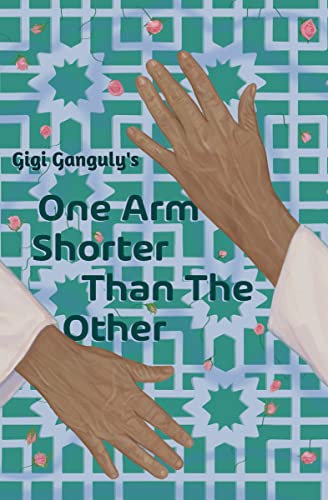Gigi Ganguly’s One Arm Shorter Than The Other begins quietly enough in 1986 as a grandfather, Maurice, a resident of Delhi, like all the characters of this beautiful debut novella, wanders in the past of his memory. That habit worries his son James, who thinks dwelling in memories is unhealthy. James feels that his father is lost in the past and forgetting to live in the present. And so, in that simple way, One Arm Shorter Than The Other introduces the idea of traveling in time, an idea that becomes quite real in a story covering thousands of years. This extraordinary novel combines psychological realism, science fiction and fantasy in a uniquely hopeful story of the interweaving of time and relationships.
Maurice summons the past as he talks to his grandchildren and gets old films and a projector out of storage. The projector breaks down and has to be taken to a repair shop. There Maurice is taken back in time in a different way as he looks over all the old machines and devices that line the shelves. He and his family meet the older gentlemen with one arm shorter than the other, named Arun, who fixes the machine. When they take it home and start watching the movies, they are stunned to find that everything on the screen seems so real. Eunice, Maurice’s late wife, seems to come to life, along with his brother Horace, who died long ago. They are startled on finding they can actually feel the objects on film when they reach out to touch them.
“There, right there, on the white background is a very young Eunice, dark-haired and smooth-skinned, beaming at the camera. It feels very real, as if they are standing right in front of her. They can hear her, too—the soft, gentle curls of laughter. But more than that, they can feel her presence, and the crisp scent of the morning. And even though they know the film is in black and white, they can see the colour of her clothes, the off-white tone of the Connaught Place buildings behind her, and the light blue of the sky above.”
One Arm Shorter Than The Other, Kindle edition, location 294.
Then we shift to 1994 and meet an out-of-work actor, Paritosh, who turns to drink in his frustration at messing up his career. After a blackout he discovers that he has broken the screen of the small family television. He takes it to the same repair shop in Old Delhi that Maurice had visited, and there Arun quickly fixes it. When he goes home and starts watching the tv, he finds that he is the star of every show, from dramas to cooking shows to the news where he is the lead anchor. Soon he disappears into the tv, and it is only by watching him on screen that his family can talk to him.
Next the story takes us to 2016, and we find a group of booksellers presenting a retiring teaching, Inaya, with a vintage radio. But it turns out that it has to be fixed. When she takes it to Arun’s shop, the kindly gentleman makes his repairs. But on returning home and turning on the radio, Inaya hears a voice talking to her and soon establishes a friendship with a man named Orko 23 from the future of 4016.
How these three incidents and the people living through them are related gradually becomes clear as One Arm Shorter Than The Other takes us farther and farther into the future. At every step we meet interesting people and learn how their lives are intertwined, all with the help of the apparently ageless Arun and his little repair shop.
This delightful novella leads us from what seems an everyday world deeper and deeper into mysteries about time, time travel and relationships spanning thousands of years. All with the utmost simplicity of style and careful portraits of fascinating characters. No heroics, no saving of humanity from terrible threats, just a quietly realistic portrait of people growing old, reliving their memories, sometimes pursuing success in self-destructive ways, coping with family and falling in love. The repairman Arun has a remarkable story of his own that turns on a number of apparently chance encounters and the collapse of a certain clocktower. This quietly accomplished story weaves some complex ideas about time through the lives of its characters and drew me in completely.
One Arm Shorter Than The Other is a captivating tale that puts character, family bonds, memory, love into a setting that I would call science fictional fantasy. And these days it takes a great leap of faith to look thousands of years into the future and find that people and the world are basically just fine. In our time of dystopia, that sort of vision is quite contrarian and absolutely wonderful.





Leave a Reply